Types of Pond Sliders
The US is home to 4 types of pond sliders namely red-eared sliders, Cumberland sliders, yellow-bellied sliders, and big bend sliders. While the first three are widely disturbed and readily available, the big bend slider is listed as vulnerable and its population has been on the decline to various factors.
Pond sliders are generally medium-sized semi-aquatic turtle species and are native to North America. The red-eared slider is the most common of all and is a favorite for many people in the pet trade.
It has also been introduced into other parts of the world by pet releases into the wild by their pet owners.
Our guide below discuss, in more detail, the types of pond sliders found in the US. For each species, you’ll learn the basics, such as physical appearance, average adult size, habitat, diet, conservation status, and more.
1. Cumberland slider
Contents
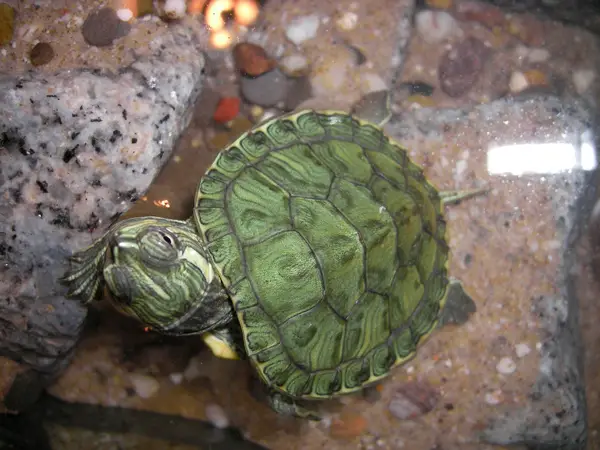
- Scientific name: Trachemys scripta troostii
- Common name: Cumberland turtle, Troost’s turtle
- Family: Emydidae
- Size: 7 to 11 ½ inches
- Lifespan: 40 to 50 years
- Conservation status: Least Concern
The Cumberland is also native to the United States and is present in Virginia, Georgia, and Tennessee.
As a subspecies of pond sliders, this turtle is a close relative of yellow-bellied sliders and red-eared sliders. The turtles are native to the Southeastern United States.
In Tennessee state, they live in the Tennessee and Cumberland river systems.
These medium-sized semi-aquatic turtles’ upper shells range from olive green to brown and feature yellow markings. They also feature yellow stripes behind their eyes.
The lower side of the shell is usually yellow with several black spots. Skin color is usually olive, green, or black, and it has multiple yellow stripes.
Cumberland sliders are omnivorous and feed on insects, mollusks, worms, dark leafy land vegetation, and aquatic vegetation.
2. Red-eared slider
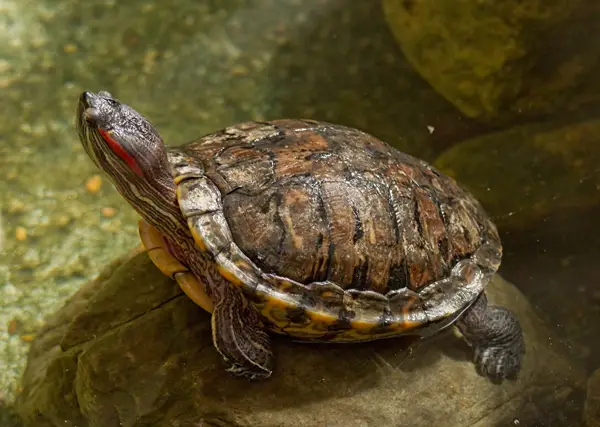
- Scientific name: Trachemys scripta
- Common name: Red-eared Slider, Red-eared Terrapin
- Family: Emydidae
- Size: 7 to 11 inches
- Lifespan: 30 to 40 years
- Conservation status: Least Concern
The red-eared slider is one of the most widespread turtle species in the US. It is present in many states, including Alabama, Indiana, Iowa, Arkansas, California, Arizona, New Mexico, and Delaware, among others.
It is a semi-aquatic turtle and prefers living in marshes, ponds, lakes, and creeks.
A red-eared slider gets its name from the small red stripe surrounding its ears (or behind the eye), and its ability to quickly slide off logs and rocks into the water.
Generally, the skin and shell coloration of this slider can be brown or black, with yellow stripes covering the skin.
The red-eared sliders are pretty large, and the adults reach 7-12 in length (though females are generally larger than males).
These pond sliders are omnivorous and like eating fish, snails, insects, and aquatic vegetation. They also eat land vegetation, including fruits and vegetables.
3. Yellow-bellied slider
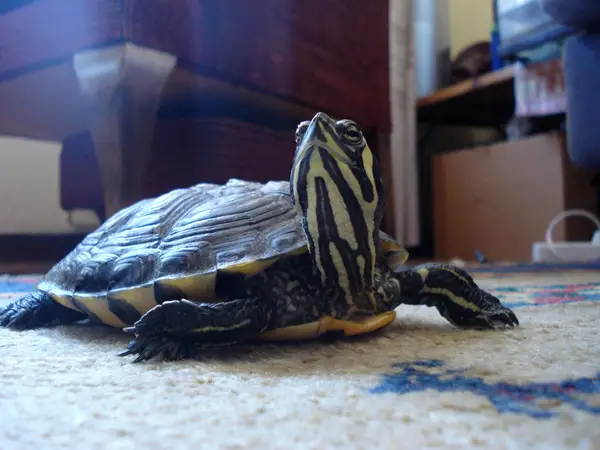
- Scientific name: Trachemys scripta scripta
- Common name: Yellow-bellied slider
- Family: Emydidae
- Size: 8 to 13 inches (females), 5 to 9 inches (males)
- Lifespan: 30 to 40 years
- Conservation status: Least Concern
The yellow-bellied slider turtle is a sub-species of pond sliders native to the Southern region of the United States. It inhabits Georgia, Mississippi, Tennessee, Virginia, South Carolina, North Carolina, Maryland, Kansas, and Florida.
It is a semi-aquatic turtle that lives in water as well as on land. And it can be found in a variety of habitats, including floodplain swamps, slow-moving rivers, seasonal wetlands, marshes, and even permanent ponds.
As the name suggests, this turtle features a yellowish plastron. Plus, it bears yellowish markings on its skin, not to forget prominent yellow stripes behind its eyes. The upper shell color ranges from dark brown to olive.
These sliders are omnivorous and like eating fish, snails, insects, and aquatic vegetation. They also eat land vegetation, including fruits and vegetables.
It is also worth noting that yellow-bellied sliders are a popular choice of pet turtles for most folks. They don’t require a lot of special care, which makes them a favorite for many folks.
4. Big Bend Slider
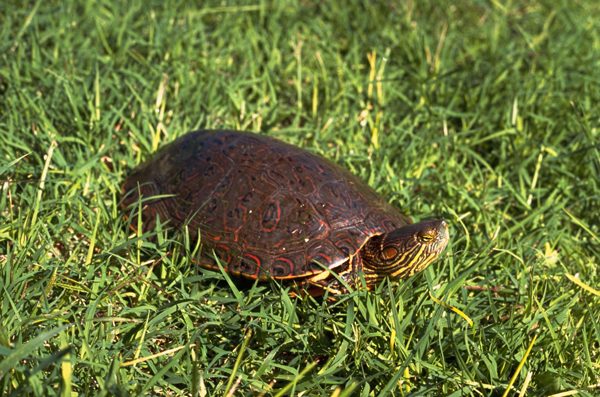
- Scientific name: Trachemys Gaigeae
- Common name: Big Bend Slider, Mexican Plateau Slider
- Family: Emydidae
- Size: 5 to 11 inches
- Lifespan: 20 to 30 years
- Conservation status: Vulnerable
The big bend slider, also known Mexican plateau slider, is another semi-aquatic turtle native to New Mexico and Texas states.
It is pretty close in appearance to its close cousin, the red-eared slider, with the exception that it has fewer red patches around its eyes.
The big bend slider’s upper shell color ranges from olive to dark brown and is covered with a yellow, orange, or red pattern. And the lower side of the shell is yellowish with a few dark spots.
Big bend slider skin color is usually the same as the carapace and is covered in yellow stripes. Two red spots can be easily spotted on each side near its head.
You’ll find this big bend slider in the pond and rivers. The turtle is also fond of basking.
These sliders are mainly herbivorous and like feeding on vegetation as well as fruits, unlike their counterparts (the red-eared sliders) which are omnivorous.
Conclusion
The four pond slider turtle species you’ll find in the US include red-eared sliders, yellow-bellied sliders, Cumberland sliders, and big bend sliders. These turtles are popular in turtle markets for markets and amphibians.
Red-eared sliders are the most common of all these species. They are also widespread across many states in the wild, where they get released into the wild by turtle owners. For this reason, they’re regarded as an invasive species in many states.
Note that these IUCN lists all the pond sliders as Least Concern except for the big bend sliders. This means the other species aren’t threatened or endangered.
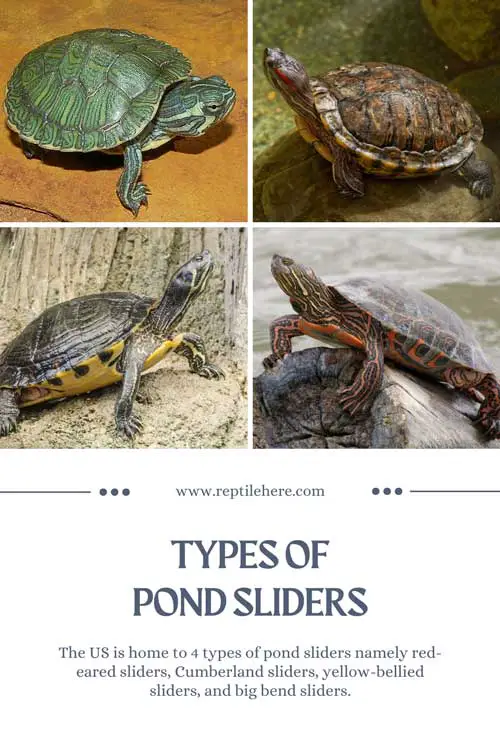

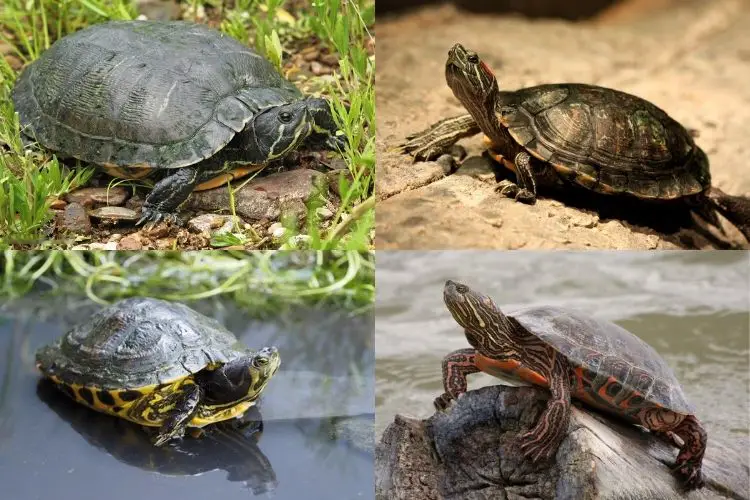
Hi,
I was wondering what type of turtle is in the 1st, top left, photo? My new turtle looks exactly like that, TIA.